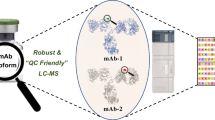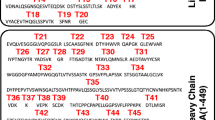Abstract
During antibody drug research and development, it is important to make sure the protein therapeutics are biosynthesized correctly, and peptide mapping works as a powerful analytical approach to confirm the identity of the monoclonal antibodies (mAbs). In this study, a novel quality control method combining tryptic peptide mapping with QDa detector for characterization of biotherapeutics was developed and validated. The peptides derived from complementarity determining regions (CDRs) of adalimumab were used as surrogates of adalimumab. Ten other antibody drugs were used to assess the method specificity. The results showed that this method has high specificity due to the high UV–MS selectivity; the limit of detection was 20 μg mL−1; carry-over was about 1.69 %. Additionally, other validation parameters, like stability, were also evaluated. This novel LC–UV–QDa method may be a simple, cost-effective and robust peptide-mapping method for other recombinant monoclonal antibodies during routine quality control analysis.





Similar content being viewed by others
References
Nelson AL, Dhimolea E, Reichert JM (2010) Nat Rev Drug Discov 9:767–774
Smith SL (1996) J Transpl Coord 6:109–119
Rau R (2002) Ann Rheum Dis 61:ii70–ii73
Hudis CA (2007) N Engl J Med 357:39–51
Locksley RM, Killeen N, Lenardo MJ (2001) Cell 104:487–501
Hu S, Liang S, Guo H, Zhang D, Li H, Wang X, Yang W, Qian W, Hou S, Wang H, Guo Y, Lou Z (2013) J Biol Chem 288:27059–27067
Liang S, Dai J, Hou S, Su L, Zhang D, Guo H, Hu S, Wang H, Rao Z, Guo Y, Lou Z (2013) J Biol Chem 288:13799–13807
Poddubnyy D, Rudwaleit M (2011) Expert Opin Drug Saf 10:655–673
Mease PJ (2007) Ther Clin Risk Manag 3:133–148
Lapadula G, Marchesoni A, Armuzzi A, Blandizzi C, Caporali R, Chimenti S, Cimaz R, Cimino L, Gionchetti P, Girolomoni G, Lionetti P, Marcellusi A, Mennini FS, Salvarani C (2014) Int J Immunopathol Pharmacol 27:33–48
Burmester GR, Panaccione R, Gordon KB, McIlraith MJ, Lacerda AP (2013) Ann Rheum Dis 72(4):517–524. doi:10.1136/annrheumdis-2011-201244
Burness CB, Keating GM (2013) BioDrugs 27:247–262
GEN (2014) top 25 best selling Drugs of 2014.http://www.genengnews.com/insight-and-intelligence/the-top-25-best-selling-drugs-of-2014/77900383/#gsaccess. Accessed 23 Feb 2015
Unutzer J, Schoenbaum M, Katon WJ, Fan MY, Pincus HA, Hogan D, Taylor J (2009) J Am Geriatr Soc 57:506–510
Woods RJ, Xie MH, Von Kreudenstein TS, Ng GY, Dixit SB (2013) MAbs 5:711–722
Li F, Vijayasankaran N, Shen AY, Kiss R, Amanullah A (2010) MAbs 2:466–479
Pharmacopeia US (USP) General Chapter <129> Analytical procedures for recombinant therapeutic monoclonal antibodies. http://www.usp.org/global/medicines-compendium
Geromanos SJ, Vissers JP, Silva JC, Dorschel CA, Li GZ, Gorenstein MV, Bateman RH, Langridge JI (2009) Proteomics 9:1683–1695
Xie H, Gilar M, Gebler JC (2009) Anal Chem 81:5699–5708
ICH (1996) The international conference on harmonisation of technical requirements for registration of pharmaceuticals for human use (ICH)-Q2; Validation of analytical procedures: text and methodology. http://www.ich.org/products/guidelines/quality/article/quality-guidelines.html
China State Food and Drug Administration (CFDA) (2011) Guidance of good manufacturing practices for drug. http://eng.sfda.gov.cn/WS03/CL0768/65113.html
FDA (2013) Guidance for industry: bioanalytical method validation (DRAFT GUIDANCE), pp 1–28. http://www.fda.gov/Drugs/GuidanceComplianceRegulatoryInformation/Guidances/default.htm
Aguilar MI, Mougos S, Boublik J, Rivier J, Hearn MT (1993) J Chromatogr 646:53–65
Dodge Y (2003) The Oxford dictionary of statistical terms, OUP. ISBN 0-19-920613-9
Ejigu BA, Valkenborg D, Baggerman G, Vanaerschot M, Witters E, Dujardin JC, Burzykowski T, Berg M (2013) OMICS 17:473–485
Stout SJ, daCunha AR (1990) Org Mass Spectrom 25:187–190. doi:10.1002/oms.1210250402
Jiang H, Zeng J, Titsch C, Voronin K, Akinsanya B, Luo L, Shen H, Desai DD, Allentoff A, Aubry AF, Desilva BS, Arnold ME (2013) Anal Chem 85:9859–9867
Xiaoyun PBL, Yantao L, Hui W (2015) Chromatographia 78:521–531
Rodrigues JC, Neto AJ, Fernandes C, Alves C, Contadori AS, Lancas FM (2006) J Chromatogr A 10:1–2
Acknowledgments
This work was supported by grants from the Natural Science Foundation of China (81330061), Ministry of Science and Technology of China (973 projects 2010CB833605 and 863 projects 2011AA020114, 2014AA021004), State Key Project for New Drug Development (2013ZX09101021; 2013ZX09401303), Shanghai Rising-Star Program, Shanghai Key Laboratory of Cell Engineering (14DZ2272300), Shanghai Key technologies R&D Program of Biological medicine (15431906100) and Shanghai Excellent technical leader (13XD1424000).
Author information
Authors and Affiliations
Corresponding authors
Ethics declarations
Conflict of interest
On behalf of all authors, the corresponding author states that there is no conflict of interest.
Additional information
J. Zhang, T. Qin and L. Xu have contributed equally to this work.
Electronic supplementary material
Below is the link to the electronic supplementary material.
Rights and permissions
About this article
Cite this article
Zhang, J., Qin, T., Xu, L. et al. Development and Validation of a Peptide Mapping Method for the Characterization of Adalimumab with QDa Detector. Chromatographia 79, 395–403 (2016). https://doi.org/10.1007/s10337-016-3046-8
Received:
Revised:
Accepted:
Published:
Issue Date:
DOI: https://doi.org/10.1007/s10337-016-3046-8




